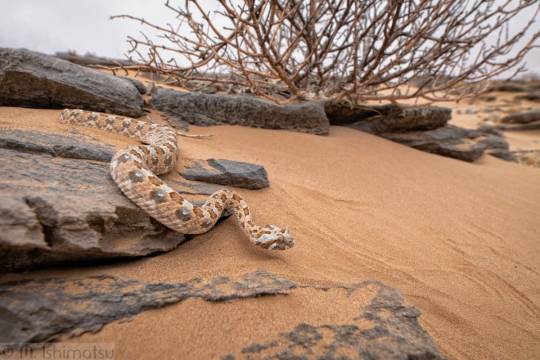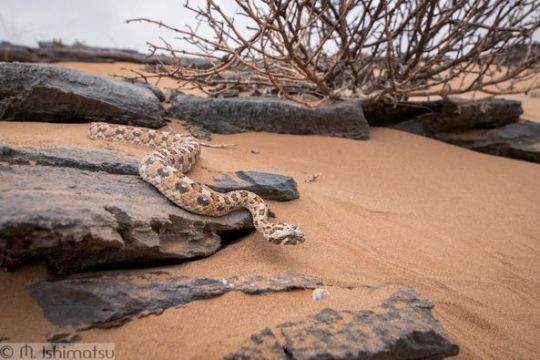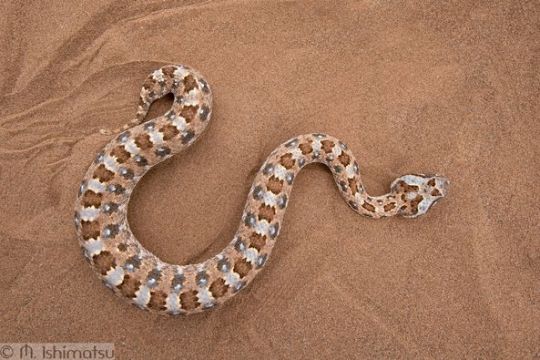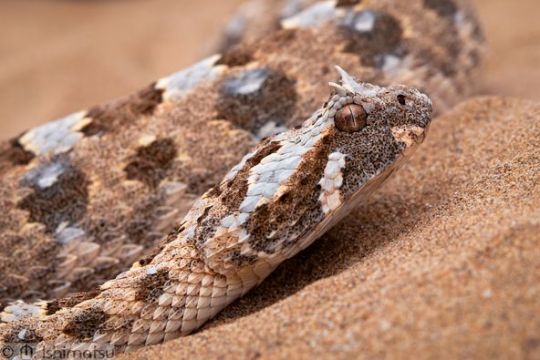#bitis caudalis
Explore tagged Tumblr posts
Text

Desert mountain adder (Bitis xeropaga)
Photographer Spends 10 Days Tracking Down Snakes in Namibia
Photographer: Marisa Ishimatsu

Many-horned adder (Bitis cornuta)

Horned adder (Bitis caudalis)

Namaqua dwarf adder (Bitis schneideri)
#marisa ishimatsu#photographer#namibia#desert mountain adder#adder#snake#bitis xeropaga#reptile#many-horned adder#bitis cornuta#horned adder#bitis caudalis#namaqua dwarf adder#bitis schneideri
27 notes
·
View notes
Text

Bitis caudalis, Horned Adder. Sessriem Canyon, Namibia.

#synsphotos#wildlife photography#syns nature adventures#snakes#snake#bitis#horned adder#bitis caudalis#namibia#i feel the need to clarify that I didn't get as close to it as it looks like in these photos...
1 note
·
View note
Text



Horned Adder (Bitis caudalis), family Viperidae, Namibia
Venomous.
photograph by Marisa Ai Ishimatsu
266 notes
·
View notes
Text

Horned Adder (Bitis caudalis)
7 notes
·
View notes
Photo

(Bitis caudalis) horned adder
Venom primarily cytotoxic, w/ local swelling & intense pain & vomiting, little or no necrosis. Venom of this species is mildly anticoagulent & possibly the least potent of any species in this genus. Very few bites & no human fatalities recorded.
44 notes
·
View notes
Photo

Todays Snake Is:
The Horned Puff Adder (Bitis caudalis) is a venomous snake native to southern Africa. These animals thrive in arid habitats where they often bury themselves in sand or loose soil in wait for prey. The purpose of the horns found above each eye is not well-understood.
(x)
169 notes
·
View notes
Text
Classification of Venomous Snakes

Classification of venomous snakes and comprehensive information on snake bites, first aid, treatment, and prevention: (in alphabetical order)
Acanthophis antarcticus (Common Death Adder)
Agkistrodon bilineatus (Mexican Cantil)
Agkistrodon contortrix (Copperhead)
Agkistrodon laticinctus (Broad Banded Copperhead)
Agkistrodon piscivorus (Cottonmouth)
Agkistrodon taylori (Castellana)
Ahaetulla nasuta (Long Nosed Whip Snake)
Aipysurus apraefrontalis (Short-Nosed Sea Snake) - true sea snake; Timor Sea; inhabits shallow coral reef waters;
Aipysurus duboisii (Dubois' Sea Snake) - slightly aggressive; true sea snake; north of Australia and parts of southwestern Pacific Ocean; inhabits shallow reef waters and sandy bottoms;
Aipysurus eydouxii (Spine-Tailed Sea Snake) - not easily provoked; true sea snake; north of Australia and around tropical islands of Southeastern Asia; inhabits shallow bay waters and muddy estuarine bottoms;
Aipysurus foliosquama (Leaf-Scaled Sea Snake) - true sea snake; Timor Sea; inhabits shallow coral reef waters and seagrass bottoms;
Aipysurus fuscus (Dusky Sea Snake) - true sea snake; Timor Sea and Java Sea; inhabits shallow reef waters and sandy sea bottoms;
Aipysurus laevis (Olive Brown Sea Snake) - highly venomous and inquisitive; true sea snake; north of Australia and southwestern Pacific Ocean; inhabits coral reef waters;
Aipysurus pooleorum (Shark Bay Sea Snake) - highly venomous; true sea snake; Shark Bay, west of Australia; inhabits limestone reefs, seabed, and seagrass floor;
Amphiesma stolatum (Buff Striped Keelback)
Aspidelaps lubricus (Cape Coral Snake)
Aspidelaps scutatus (Shield Nose Snake)
Atheris squamigera (African Bush Viper)
Atractaspis bibronii (Bibron's Burrowing Asp)
Atractaspis dahomeyensis (Dahomey Burrowing Asp)
Atractaspis engaddensis (Palestinian Mole Viper)
Atractaspis microlepidota (Small Scaled Burrowing Asp)
Atropoides picadoi (Picado's Jumping Pitviper)
Austrelaps superbus (Lowland Copperhead)
Azemiops feae (Fea's Viper)
Bitis arietans (Puff Adder)
Bitis atropos (Cape Mountain Adder)
Bitis caudalis (Horned Puff Adder)
Bitis cornuta (Western Many Horned Adder)
Bitis gabonica (Central African Gaboon Viper)
Bitis nasicornis (Rhinoceros Viper)
Bitis parviocula (Ethiopian Mountain Adder)
Bitis rhinoceros (West African Gaboon Viper)
Boiga cyanea (Green Cat Snake)
Boiga dendrophila (Mangrove Snake)
Boiga irregularis (Brown Tree Snake)
Bothriechis lateralis (Side Striped Palm Viper)
Bothriechis nigroviridis (Black Speckled Palm Pitviper)
Bothriechis schlegelii (Eyelash Palm Pitviper)
Bothrops alternatus (Urutú)
Bothrops asper (Terciopelo)
Bothrops atrox (Common Lancehead)
Bothrops ayerbei (Ayerbe's Lancehead)
Bothrops caribbaeus (Saint Lucia Lancehead)
Bothrops cotiara (Cotiara)
Bothrops diporus (Chaco Lancehead)
Bothrops erythromelas (Caatinga Lancehead)
Bothrops fonsecai (Fonseca's Lancehead)
Bothrops insularis (Golden Lancehead Viper)
Bothrops itapetiningae (São Paulo Lancehead)
Bothrops jararaca (Jararaca)
Bothrops jararacussu (Jararacussu)
Bothrops lanceolatus (Martinique Lancehead)
Bothrops leucurus (Whitetail Lancehead)
Bothrops mattogrossensis (Mato Grosso Lanzenotter)
Bothrops moojeni (Brazilian Lancehead)
Bothrops neuwiedi (Neuwied's Lancehead)
Bothrops pauloensis (Black Faced Lancehead)
Bothrops taeniatus (Speckled Forest Pitviper)
Bungarus caeruleus (Indian Krait)
Bungarus candidus (Blue Krait)
Bungarus fasciatus (Banded Krait)
Bungarus flaviceps (Red Headed Krait)
Bungarus multicinctus (Many Banded Krait)
Calloselasma rhodostoma (Malayan Pitviper) - highly venomous and irritable; Southeastern Asia; terrestrial and usually nocturnal; often found near agricultural lands;
Causus rhombeatus (Common Night Adder)
Cerastes cerastes (Horned Viper)
Cerastes gasperettii (Arabian Horned Viper)
Cerastes vipera (Sahara Sand Viper)
Cerrophidion godmani (Godman's Montane Pitviper)
Cerrophidion sasai (Costa Rica Montane Pitviper)
Here is the full list of Venomous Snakes. https://www.dovemed.com/classification-disorders-and-tumors/classification-venomous-snakes/
#snake#snakes#lancehead#viper#venomoussnakes#classification#firstaid#health#who#worldhealthorganization#cobra#southamerica#asia#europe
11 notes
·
View notes
Photo

aesthetic
19 notes
·
View notes
Photo

Late for the #worldsnakeday ? Well, I think it’s never too late to appreciate the beauty and the uniqueness of these animals. I’m growing tired of “days of” and I’d like everyone of us could respect and why not, even love these underestimated jewels of nature. In this image, a spiny souvenir from my last trip to Namibia last year, a macro portrait of the amazing horned adder (Bitis caudalis). #snake #herps #herpsofinstagram #picoftheday #herpetology #serpent #bitiscaudalis #macro #macrophotography #portraitphotography @ilcp_photographers https://www.instagram.com/p/CCvhQAoAQhK/?igshid=ja9bz6zv1goc
#worldsnakeday#snake#herps#herpsofinstagram#picoftheday#herpetology#serpent#bitiscaudalis#macro#macrophotography#portraitphotography
3 notes
·
View notes
Photo

Horned adder (Bitis caudalis), I almost stepped on this one and screamed for Christopher @chris_caine_88 to come help, at least we got some nice photos... #southafrica #thisissouthafrica #naturelovers #twotracksadventures #nikonsa #natgeo #natgeoyourshot #natgeowild #wild #wildlife #wildlifephotography #wildlifephotos #snake #nature #coldblooded #reptilesofinstagram #snakes #snakestepped #snakesofig #snakesofinstagram #4by4 https://www.instagram.com/p/CDwxcakF4Aw/?igshid=1jzacxzt2c3pk
#southafrica#thisissouthafrica#naturelovers#twotracksadventures#nikonsa#natgeo#natgeoyourshot#natgeowild#wild#wildlife#wildlifephotography#wildlifephotos#snake#nature#coldblooded#reptilesofinstagram#snakes#snakestepped#snakesofig#snakesofinstagram#4by4
0 notes
Text
Wuster gang of thieves find Hoser discovered species valid - claims discovery their own .... five years later!
Wuster et al. tested the Hoser 2013 taxonomy of vipers hoping to get proof he was wrong only to bomb out totally. Their recent so-called paper is dated 2018. It is the usual collection of rubbish you'd expect from Wuster, in that he steals the work of Hoser and masquerades it as his own. Bitis matteoae Hoser, 2013 was confirmed as a full and valid species. .... as if it wasn't obvious! Bitis (Klosevipera) caudalis kajerikbulliardi Hoser, 2013 was shown up as a full species - thanks gents. Pity the slimebags identified these taxa as full species, but then failed to cite the work that originally drew their attention to these snakes (and had named them five years prior), namely the peer reviewed scientific paper of Raymond Hoser five years earlier. This is called scientific fraud on their part .... remanufacturing another person's findings as their own. It is also called plagiarisation. Funny thing is that for the last 5 years these fools have been telling people that the relevant species named by Hoser were "non species" and they even published a rant called "Kaiser et al" saying that all should be synonymized. PS Don't wait for an apology now. Just so no one else misses out on who is who in the zoo, the Hoser paper is as follows: Hoser, R. T. 2013. African Adders (Bitis Gray, 1842), reviewed, including, two new subgenera, five new species of Puff Adder, all formerly Bitis arietans (Merrem, 1820) subspecific division of Bitis caudalis (Smith, 1839) and division of the Berg Adders Bitis atropos (Linnaeus, 1758) (Serpentes: Viperidae: Bitisini). Australasian Journal of Herpetology 19:3-24. Published 10 July 2013. Full text available at http://www.smuggled.com/AJH-I19-Split.htm
0 notes
Text

Horned Adder (Bitis caudalis)
1 note
·
View note
Photo

(Bitis caudalis) horned adder, horned puff adder Very few bites & no human fatalities recorded. Venom primarily cytotoxic, w/ local swelling & intense pain & vomiting, little or no necrosis. Venom of this species is mildly anticoagulant & possibly the least potent of any species in this genus.
132 notes
·
View notes
Video
Bitis caudalis by Thor Hakonsen
#Animalia#Bitis caudalis#Reptilia#Serpentes#Squamata#Viperidae#Vipers#reptiles#slanger#snakes#vertebrates#Reptile#Viper#Horned Adder#Photo#Thor Hakonsen#Nature
1 note
·
View note


